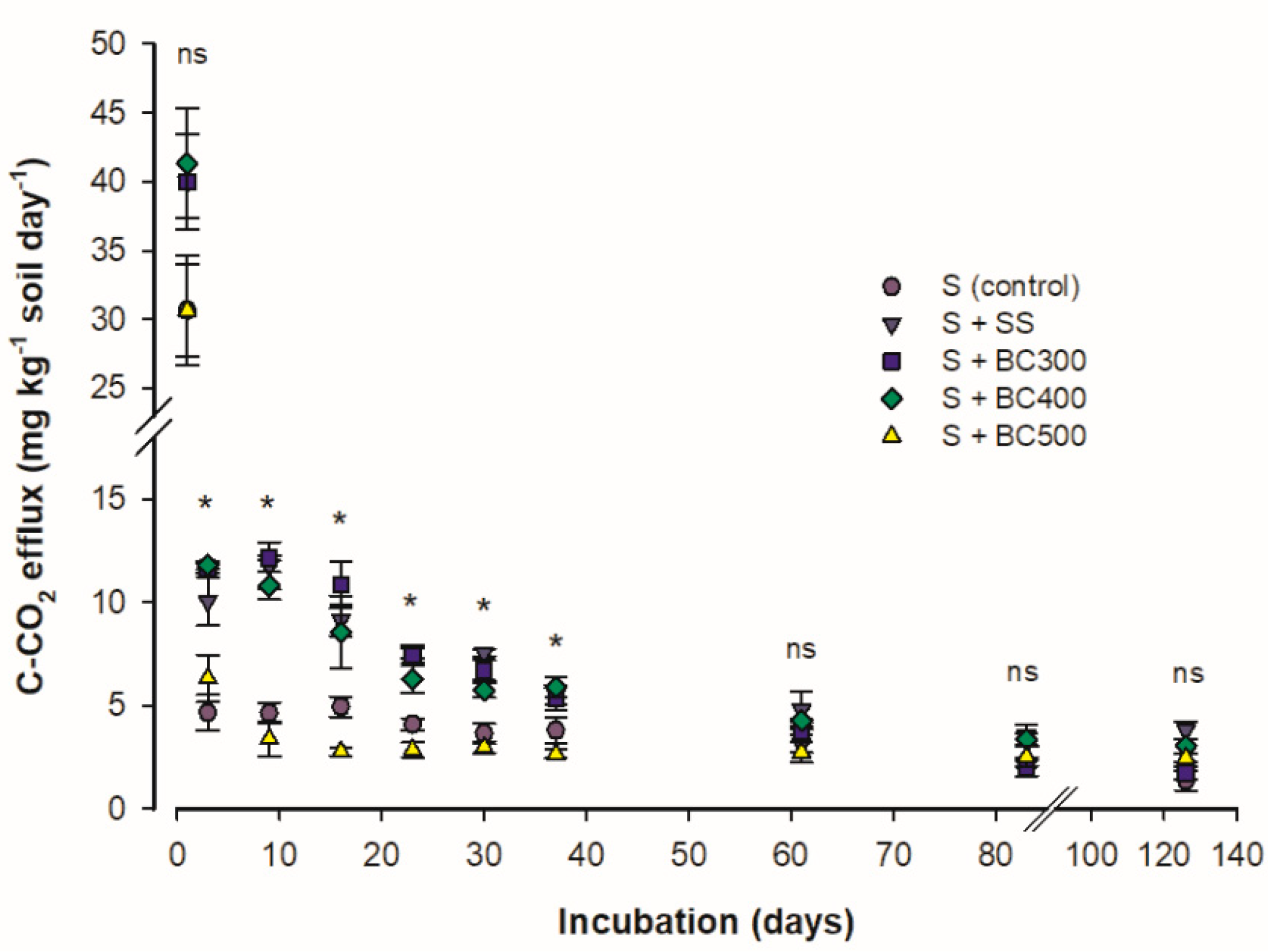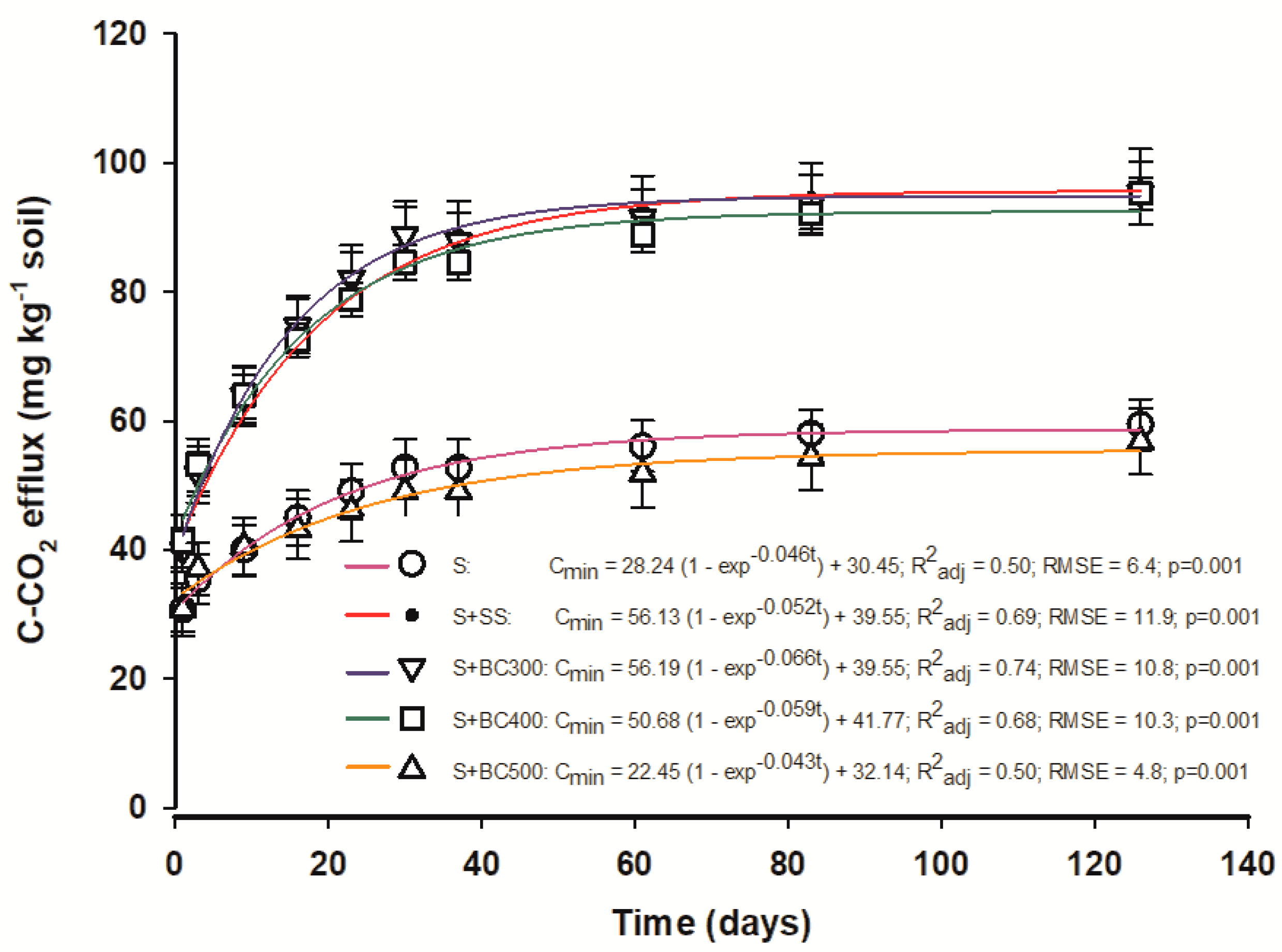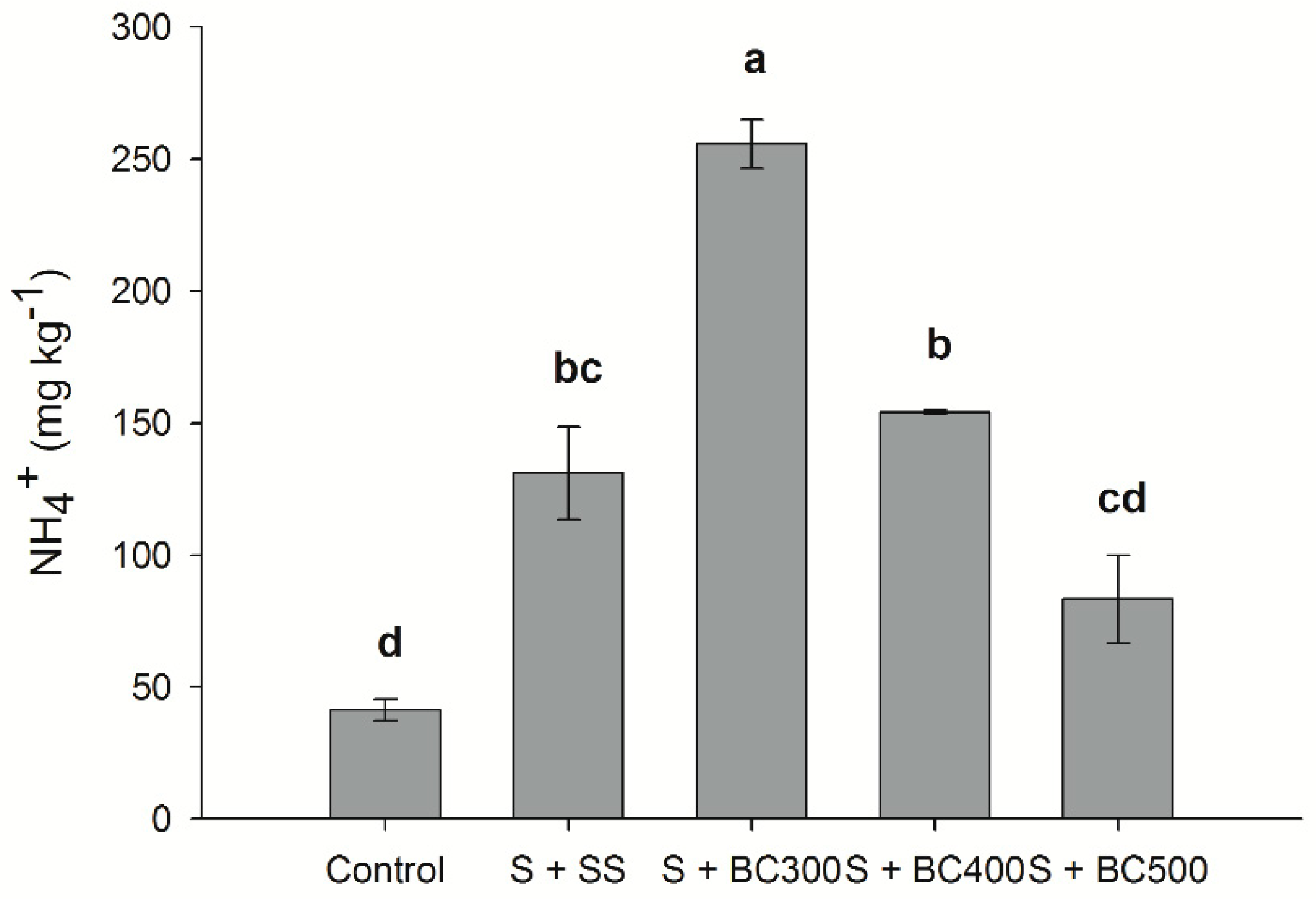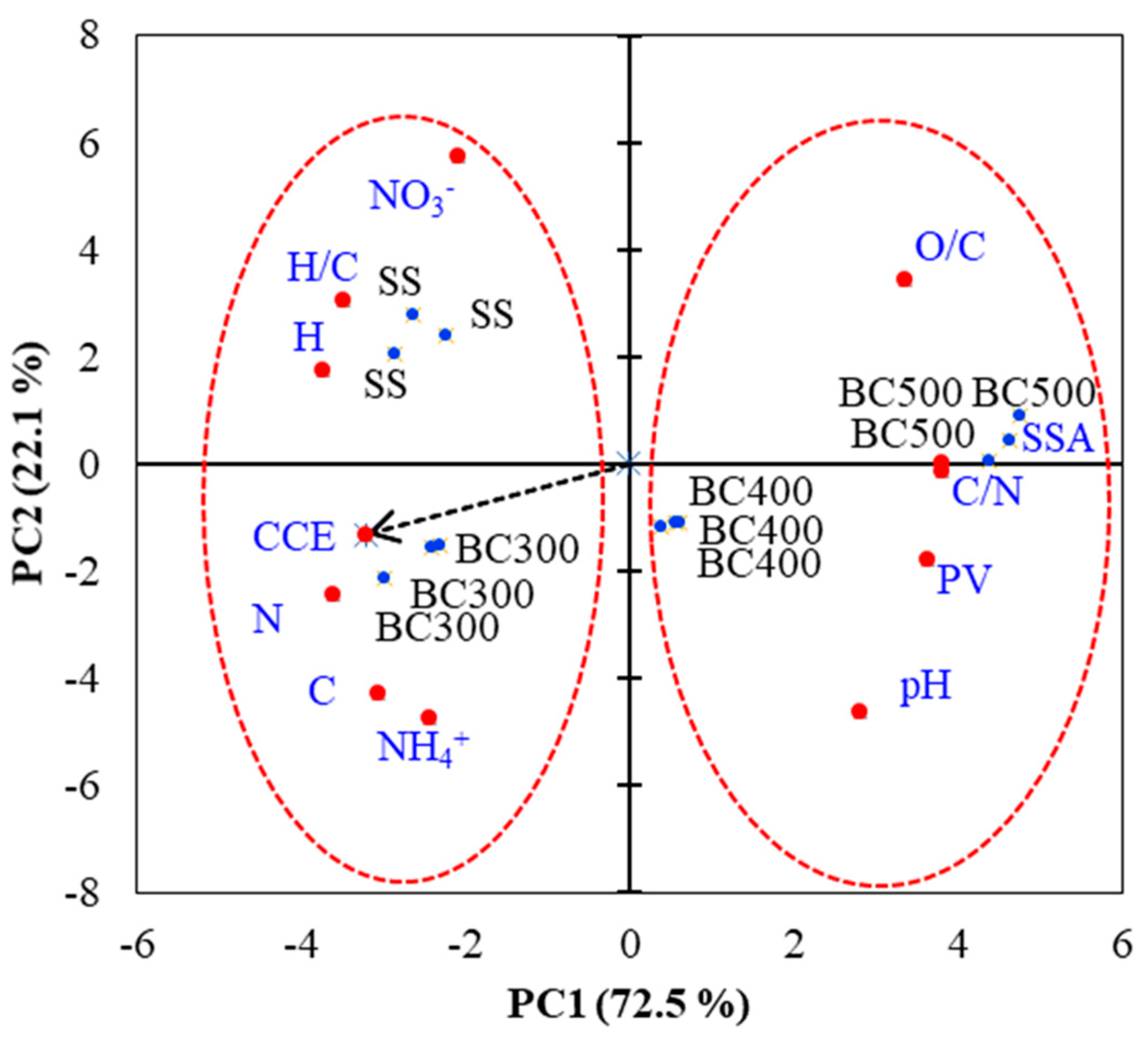Carbon Mineralization in a Soil Amended with Sewage Sludge-Derived Biochar
Abstract
:1. Introduction
2. Materials and Methods
2.1. Soil Characteristics
2.2. Biochar Production
2.3. Physicochemical Characterization of Biochars
2.4. Incubation Experiment
2.5. Chemical Analyses of Available Nitrogen
2.6. Carbon Mineralization Kinetics Model
2.7. Statistical Analyses
3. Results and Discussion
3.1. General Properties of the Soil, Sewage Sludge, and Biochars
3.2. The Dynamics of C Mineralization
3.3. Kinetics of C-CO2 Efflux
3.4. Nitrogen Availability
3.5. Relationship between C Mineralization and Available N in Soil Amended with Biochar
4. Conclusions
Author Contributions
Funding
Conflicts of Interest
References
- Caballero, J.A.; Front, R.; Marcilla, A.; Conesa, J.A. Characterization of sewage sludges by primary and secondary pyrolysis. J. Anal. Appl. Pyrolysis 1997, 40–41, 433–450. [Google Scholar] [CrossRef]
- DeLuca, T.H.; Gundale, M.F.; MacKenzie, M.D.; Gundale, M.J. Bio-char effects on soil nutrient transformation. In Biochar for Environmental Management: Science and Technology; Lehmann, J., Stephen, J., Eds.; Earthscan: London, UK, 2009; pp. 251–270. [Google Scholar] [CrossRef]
- Figueiredo, C.C.; Chagas, J.K.M.; Silva, J.; Paz-Ferreiro, J. Short-term effects of a sewage sludge biochar amendment on total and available heavy metal content of a tropical soil. Geoderma 2019, 344, 31–39. [Google Scholar] [CrossRef]
- Bachmann, H.J.; Bucheli, T.D.; Dieguez-Alonso, A.; Fabbri, D.; Knicker, H.; Schmidt, H.P.; Ulbricht, A.; Becker, R.; Buscaroli, A.; Buerge, D.; et al. Toward the standardization of biochar analysis: The cost action TD1107 interlaboratory comparison. J. Agric. Food Chem. 2016, 64, 513–527. [Google Scholar] [CrossRef]
- Paz-Ferreiro, J.; Nieto, A.; Méndez, A.; Askeland, M.; Gascó, G. Biochar from biosolids pyrolysis: A review. Int. J. Environ. Res. Public Health 2018, 15, 956. [Google Scholar] [CrossRef]
- Sousa, A.A.T.C.; Figueiredo, C.C. Sewage sludge biochar: Effects on soil fertility and growth of radish. Biol. Agric. Hortic. 2016, 32, 127–138. [Google Scholar] [CrossRef]
- Faria, W.M.; Figueiredo, C.C.; Coser, T.R.; Vale, A.T.; Schneider, B.G. Is sewage sludge biochar capable of replacing inorganic fertilizers for corn production? Evidence from a two-year field experiment. Arch. Agron. Soil Sci. 2018, 64, 505–519. [Google Scholar] [CrossRef]
- Aguilar-Chávez, Á.; Díaz-Rojas, M.; del Rosario Cárdenas-Aquino, M.; Dendooven, L.; Luna-Guido, M. Greenhouse gas emissions from a wastewater sludge-amended soil cultivated with wheat (Triticum spp. L.) as affected by different application rates of charcoal. Soil Biol. Biochem. 2012, 52, 90–95. [Google Scholar] [CrossRef]
- Grutzmacher, P.; Puga, A.P.; Bibar, M.P.S.; Coscione, A.R.; Packer, A.P.; de Andrade, C.A. Carbon stability and mitigation of fertilizer induced N2O emissions in soil amended with biochar. Sci. Total Environ. 2018, 625, 1456–1466. [Google Scholar] [CrossRef]
- Woolf, D.; Amonette, J.E.; Street-Perrott, F.A.; Lehmann, J.; Joseph, S. Sustainable biochar to mitigate global climate change. Nat. Commun. 2010, 1, 1–9. [Google Scholar] [CrossRef]
- Spokas, K.A. Review of the stability of biochar in soils: Predictability of O:C molar ratios. Carbon Manag. 2010, 1, 289–303. [Google Scholar] [CrossRef]
- Bird, M.I.; Wynn, J.G.; Saiz, G.; Wurster, C.M.; McBeath, A. The pyrogenic carbon cycle. Annu. Rev. Earth Planet. Sci. 2015, 43, 273–298. [Google Scholar] [CrossRef]
- Bakshi, S.; Banik, C.; Laird, D.A. Quantification and characterization of chemically-and thermally-labile and recalcitrant biochar fractions. Chemosphere 2018, 194, 247–255. [Google Scholar] [CrossRef] [PubMed]
- Zimmerman, A.R. Abiotic and microbial oxidation of laboratory- produced black carbon (biochar). J. Environ. Sci. 2010, 44, 1295–1301. [Google Scholar] [CrossRef]
- Giller, K.E.; Witter, E.; McGrath, S.P. Toxicity of heavy metals to microorganisms and microbial processes in agricultural soils: A review. Soil Biol. Biochem. 1998, 30, 1389–1414. [Google Scholar] [CrossRef]
- Trannin, I.C.D.B.; Siqueira, J.O.; Moreira, F.M.D.S. Biological characteristics indicators of soil quality after two years of application of an industrial biosolid and corn cultivation. Revista Brasileira de Ciência do Solo 2007, 31, 1173–1184. [Google Scholar] [CrossRef]
- Qayyum, M.F.; Steffens, D.; Reisenauer, H.P.; Schubert, S. Kinetics of carbon mineralization of biochars compared with wheat straw in three Soils. J. Environ. Qual. 2012, 41, 1210–1220. [Google Scholar] [CrossRef]
- Figueiredo, C.; Lopes, H.; Coser, T.; Vale, A.; Busato, J.; Aguiar, N.; Novotny, E.; Canellas, L. Influence of pyrolysis temperature on chemical and physical properties of biochar from sewage sludge. Arch. Agron. Soil Sci. 2018, 64, 881–889. [Google Scholar] [CrossRef]
- Calvelo Pereira, R.; Kaal, J.; Camps Arbestain, M.; Pardo Lorenzo, R.; Aitkenhead, W.; Hedley, M.; Macías, F.; Hindmarsh, J.; Maciá-Agulló, J.A. Contribution to characterisation of biochar to estimate the labile fraction of carbon. Org. Geochem. 2011, 42, 1331–1342. [Google Scholar] [CrossRef]
- Méndez, A.; Tarquis, A.M.; Saa-Requejo, A.; Guerrero, F.; Gascó, G. Influence of pyrolysis temperature on composted sewage sludge biochar priming effect in a loamy soil. Chemosphere 2013, 93, 668–676. [Google Scholar] [CrossRef]
- Leng, L.; Xu, X.; Wei, L.; Fan, L.; Huang, H.; Li, J.; Lu, Q.; Li, J.; Zhou, W. Biochar stability assessment by incubation and modelling: Methods, drawbacks and recommendations. Sci. Total Environ. 2019, 664, 11–23. [Google Scholar] [CrossRef]
- Jiang, X.; Denef, K.; Stewart, C.E.; Cotrufo, M.F. Controls and dynamics of biochar decomposition and soil microbial abundance, composition, and carbon use efficiency during long-term biochar-amended soil incubations. Biol. Fertil. Soils 2016, 52, 1–14. [Google Scholar] [CrossRef]
- Bruun, E.W.; Hauggaard-Nielsen, H.; Ibrahim, N.; Egsgaard, H.; Ambus, P.; Jensen, P.A.; Dam-Johansen, K. Influence of fast pyrolysis temperature on biochar labile fraction and short-term carbon loss in a loamy soil. Biomass Bioenergy 2011, 35, 1182–1189. [Google Scholar] [CrossRef]
- Flavel, T.C.; Murphy, D.V. Carbon and nitrogen mineralization rates after application of organic amendments to soil. J. Environ. Qual. 2006, 35, 183–193. [Google Scholar] [CrossRef]
- Soil Survey Staff. Keys to Soil Taxonomy; USDA: Washington, DC, USA, 2004. [Google Scholar]
- IUSS Working Group WRB. World Reference Base for Soil Resources 2014. International Soil Classification System for Naming Soils and Creating Legends for Soil Maps Update 2015; FAO: Rome, Italy, 2015; 192p. [Google Scholar]
- Teixeira, P.C.; Dobagemma, G.K.; Fontana, A.; Teixeira, W.G. Manual de Métodos de Análise do Solo, 3rd ed.; Embrapa: Brasília, Brazil, 2017; 573p. [Google Scholar]
- Reatto, A.; da Silva, E.M.; Bruand, A.; Martins, E.S.; Lima, J.E.F.W. Validity of the centrifuge method for determining the water retention properties of tropical soils. Soil Sci. Soc. Am. J. 2008, 72, 1547–1553. [Google Scholar] [CrossRef]
- Mebius, L.J. A rapid method for the determination of organic carbon in soil. Anal. Chim. Acta 1960, 22, 120–124. [Google Scholar] [CrossRef]
- USEPA. Method 3050B—Acid Digestion of Sediments, Sludges, and Soils. 1996. Available online: https://www.epa.gov/hw-sw846/sw-846-test-method-3050b-acid-digestion-sediments-sludges-and-soils (accessed on 10 October 2018).
- Bremner, J.M. Nitrogen-total. In Methods of Soil Analysis; Sparks, D.L., Page, A.L., Helmke, P.A., Loeppert, R.H., Soltanpour, P.N., Tabatabai, M.A., Johnston, C.T., Sumner, M.E., Eds.; Soil Science Society America Inc.: Madison, WI, USA, 1996; Volume 5, pp. 1085–1121. [Google Scholar]
- Alef, K.; Nannipieri, P. Methods in Applied Soil Microbiology and Biochemistry, 1st ed.; Academic Press: London, UK, 1995; 576p. [Google Scholar]
- Jones, C.A. Estimation of an active fraction of soil nitrogen. Commun. Soil Sci. Plant Anal. 1984, 15, 23–32. [Google Scholar] [CrossRef]
- Little, R.C.; Milliken, G.A.; Stroup, W.W.; Wolfinger, R.D.; Schabenberger, O. SAS System for Mixed Models; SAS Institute: Cary, NC, USA, 1996; 633p. [Google Scholar]
- Addinsoft. XLSTAT: Statistical Software for Microsoft Excel. 2013. Available online: https://www.xlstat.com/en (accessed on 10 December 2018).
- Saviozzi, A.; Levi-Minzi, R.; Riffaldi, R.; Vanni, G. Role of chemical constituents of wheat straw and pig slurry on their decomposition in soil. Biol. Fertil. Soils 1997, 25, 401–406. [Google Scholar] [CrossRef]
- Coppens, F.; Garnier, P.; De Gryze, S.; Merckx, R.; Recous, S. Soil moisture, carbon and nitrogen dynamics following incorporation and surface application of labelled crop residues in soil columns. Eur. J. Soil Sci. 2006, 57, 894–905. [Google Scholar] [CrossRef]
- Anderson, C.R.; Condron, L.M.; Clough, T.J.; Fiers, M.; Stewart, A.; Hill, R.A.; Sherlock, R.R. Biochar induced soil microbial community change: Implications for biogeochemical cycling of carbon, nitrogen and phosphorus. Pedobiologia 2011, 54, 309–320. [Google Scholar] [CrossRef]
- Abdulrazzaq, H.; Jol, H.; Husni, A.; Abu-Bakr, R. Characterization and stabilisation of biochars obtained from empty fruit bunch, wood and rice husk. Bioresources 2014, 9, 2888–2898. [Google Scholar] [CrossRef]
- Maestrini, B.; Nannipieri, P.; Abiven, S. A meta-analysis on pyrogenic organic matter induced priming effect. GCB Bioenergy 2015, 7, 577–590. [Google Scholar] [CrossRef]
- Andrade, C.A.; Oliveira, C.D.; Cerri, C.C. Degradation kinetics of biosolids organic matter after soil application and its relationship with initial chemical composition. Bragantia 2006, 65, 659–668. [Google Scholar] [CrossRef]
- Zavalloni, C.; Alberti, G.; Biasiol, S.; Vedove, G.D.; Fornasier, F.; Liu, J.; Peressotti, A. Microbial mineralization of biochar and wheat straw mixture in soil: A short-term study. Appl. Soil Ecol. 2011, 50, 45–51. [Google Scholar] [CrossRef]
- Thies, J.E.; Rillig, M.C. Characteristics of biochar: Biological properties. In Biochar for Environmental Management: Science and Technology; Lehmann, J., Stephen, J., Eds.; Earthscan: London, UK, 2009; pp. 85–105. [Google Scholar]
- Bai, M.; Wilske, B.; Buegger, F.; Esperschütz, J.; Kammann, C.I.; Eckhardt, C.; Koestler, M.; Kraft, P.; Bach, M.; Frede, H.G.; et al. Degradation kinetics of biochar from pyrolysis and hydrothermal carbonization in temperate soils. Plant Soil 2013, 372, 375–387. [Google Scholar] [CrossRef]
- Chan, K.Y.; Xu, Z. Biochar: Nutrient properties and their enhancement. In Biochar for Environmental Management: Science and Technology; Lehmann, J., Stephen, J., Eds.; Earthscan: London, UK, 2009; pp. 67–84. [Google Scholar]
- Kammann, C.I.; Schmidt, H.P.; Messerschmidt, N.; Linsel, S.; Steffens, D.; Müller, C.; Koyro, H.W.; Conte, P.; Stephen, J. Plant growth improvement mediated by nitrate capture in co-composted biochar. Sci. Rep. 2015, 5, 1–13. [Google Scholar] [CrossRef]
- Haider, G.; Steffens, D.; Müller, C.; Kammann, C.I. Standard extraction methods may underestimate nitrate stocks captured by field-aged biochar. J. Environ. Qual. 2016, 45, 1196–1204. [Google Scholar] [CrossRef]
- Bagreev, A.; Bandosz, T.J.; Locke, D.C. Pore structure and surface chemistry of adsorbents obtained by pyrolysis of sewage sludge-derived fertilizer. Carbon 2001, 39, 1971–1979. [Google Scholar] [CrossRef]
- Novak, J.M.; Lima, I.; Xing, B.; Gaskin, J.W.; Steiner, C.; Das, K.C.; Schomberg, H. Characterization of designer biochar produced at different temperatures and their effects on a loamy sand. Ann. Environ. Sci. 2009, 3, 195–206. [Google Scholar]
- Hossain, M.K.; Strezov, V.; Chan, K.Y.; Ziolkowski, A.; Nelson, P.F. Influence of pyrolysis temperature on production and nutrient properties of wastewater sludge biochar. J. Environ. Manag. 2011, 92, 223–228. [Google Scholar] [CrossRef]
- Schimel, J.P.; Bennett, J. Nitrogen mineralization: Challenges of a changing paradigm. Ecology 2004, 85, 591–602. [Google Scholar] [CrossRef]
- Nelissen, V.; Rütting, T.; Huygens, D.; Staelens, J.; Ruysschaert, G.; Boeckx, P. Maize biochars accelerate short-term soil nitrogen dynamics in a loamy sand soil. Soil Biol. Biochem. 2012, 55, 20–27. [Google Scholar] [CrossRef]
- Wang, T.; Camps-Arbestain, M.; Hedley, M.; Bishop, P. Predicting phosphorus bioavailability from high-ash biochars. Plant Soil 2012, 357, 173–187. [Google Scholar] [CrossRef]
- Smith, J.L.; Collins, H.P.; Bailey, V.L. The effect of young biochar on soil respiration. Soil Biol. Biochem. 2010, 42, 2345–2347. [Google Scholar] [CrossRef]





| Property | Value |
|---|---|
| pH (CaCl2) | 5.1 ± 0.3 |
| OC b (g kg−1) | 19.4 ± 1.0 |
| P (mg kg−1) | 0.7 ± 0.1 |
| K+ (mg kg−1) | 46.1 ± 4.0 |
| Ca+2 (mmolc kg−1) | 14 ± 2 |
| Mg+2 (mmolc kg−1) | 8 ± 1 |
| SB c (mmolc kg−1) | 34 ± 5 |
| Al+3 (mmolc kg−1) | 0 ± 0 |
| H+Al (mmolc kg−1) | 37 ± 4 |
| CEC d (mmolc kg−1) | 71 ± 9 |
| V e (%) | 48.0 ± 4.0 |
| Sand (g kg−1) | 140.1 ± 5.0 |
| Silt (g kg−1) | 270.1 ± 10.0 |
| Clay (g kg−1) | 580.8 ± 25.0 |
| Properties 1 | Units | SS | BC300 | BC400 | BC500 |
|---|---|---|---|---|---|
| C | % | 21.0 ± 0.4 | 23.4 ± 0.4 | 21.6 ± 0.3 | 19.0 ± 0.2 |
| OC a Mebius | % | 20.1 ± 0.5 | 20.0 ± 0.4 | 19.0 ± 0.4 | 17.6 ± 0.3 |
| OC b W&B | % | 14.0 ± 0.4 | 14.5 ± 0.5 | 13.9 ± 0.4 | 13.3 ± 0.4 |
| N | % | 3.0 ± 0.1 | 3.3 ± 0.1 | 2.9 ± 0.1 | 2.3 ± 0.1 |
| H | % | 4.2 ± 0.1 | 3.6 ± 0.1 | 2.7 ± 0.2 | 1.7 ± 0.1 |
| C/N | 7.0 ± 0.1 | 7.0 ± 0.1 | 7.4 ± 0.3 | 8.3 ± 0.1 | |
| H/C | 2.4 ± 0.1 | 1.8 ± 0.1 | 1.5 ± 0.2 | 1.1 ± 0.1 | |
| pH | 4.8 ± 0.4 | 5.8 ± 0.2 | 6.5 ± 0.4 | 6.5 ± 0.3 | |
| P | g kg−1 | 35.7 ± 2.8 | 41.1 ± 3.2 | 53.7 ± 5.0 | 61.3 ± 5.6 |
| K | g kg−1 | 0.8 ± 0.1 | 1.6 ± 0.1 | 1.08 ± 0.1 | 1.25 ± 0.1 |
| N-NO3− | mg kg−1 | 23.3 ± 3.4 | 17.5 ± 2.8 | 5.84 ± 1.0 | 5.8 ± 0.9 |
| N-NH4+ | mg kg−1 | 461.2 ± 36.0 | 431.9 ± 31.0 | 198.5 ± 8.0 | 169.3 ± 19.8 |
| Ca | g kg−1 | 6.6 ± 0.1 | 6.7 ± 0.2 | 7.1 ± 0.4 | 8.2 ± 0.3 |
| Mg | g kg−1 | 0.8 ± 0.1 | 1.8 ± 0.1 | 1.7 ± 0.2 | 1.7 ± 0.1 |
| S | g kg−1 | 6.7 ± 0.2 | 15.1 ± 1.0 | 9.6 ± 0.8 | 7.4 ± 0.4 |
| Total Cu | mg kg−1 | 115 ± 1 | 148 ± 1 | 147 ± 2 | 145 ± 1 |
| Total Pb | mg kg−1 | 207 ± 1 | 256 ± 3 | 260 ± 8 | 265 ± 1 |
| Total Zn | mg kg−1 | 306 ± 1 | 321 ± 1 | 368 ± 4 | 411 ± 5 |
| Total Cr | mg kg−1 | 100 ± 1 | 106 ± 2 | 122 ± 5 | 136 ± 1 |
| Total Co | mg kg−1 | 20 ± 1 | 22 ± 1 | 24 ± 2 | 25 ± 1 |
| Total Mn | mg kg−1 | 56 ± 1 | 58 ± 1 | 68 ± 4 | 80 ± 2 |
| Moisture c | g g−1 | 0.17 ± 0.01 | 0.004 ± 0.001 | 0.003 ± 0.001 | 0.003 ± 0.001 |
| SSA d | m2 g−1 | 18.2 ± 1.2 | 20.2 ± 1.8 | 29.85 ± 2.1 | 52.5 ± 4.3 |
| PV e | mL g−1 | 0.022 ± 0.001 | 0.027 ± 0.001 | 0.046 ± 0.003 | 0.053 ± 0.002 |
| Ash | g g⁻¹ | 0.54 ± 0.03 | 0.59 ± 0.02 | 0.68 ± 0.2 | 0.79 ± 0.04 |
| Yield | % | - | 86 ± 8 | 75 ± 5 | 65 ± 4 |
| Materials | CCE (mg of C-CO2 kg−1 of Soil) | |
|---|---|---|
| S | 63.2 | b |
| S + SS | 103.8 | a |
| S + BC300 | 101.6 | a |
| S + BC400 | 101.1 | a |
| S + BC500 | 59.4 | b |
| Variables | PC1 | PC2 |
|---|---|---|
| pH | 0.726 | −0.662 |
| C | −0.788 | −0.609 |
| H | −0.966 | 0.248 |
| N | −0.933 | −0.348 |
| C/N | 0.986 | −0.023 |
| H/C | −0.897 | 0.436 |
| O/C | 0.868 | 0.491 |
| CCE | −0.826 | −0.188 |
| NO3− | −0.534 | 0.818 |
| NH4+ | −0.626 | −0.677 |
| PV | 0.938 | −0.254 |
| SSA | 0.987 | 0.000 |
© 2019 by the authors. Licensee MDPI, Basel, Switzerland. This article is an open access article distributed under the terms and conditions of the Creative Commons Attribution (CC BY) license (http://creativecommons.org/licenses/by/4.0/).
Share and Cite
Figueiredo, C.C.d.; Coser, T.R.; Moreira, T.N.; Leão, T.P.; Vale, A.T.d.; Paz-Ferreiro, J. Carbon Mineralization in a Soil Amended with Sewage Sludge-Derived Biochar. Appl. Sci. 2019, 9, 4481. https://doi.org/10.3390/app9214481
Figueiredo CCd, Coser TR, Moreira TN, Leão TP, Vale ATd, Paz-Ferreiro J. Carbon Mineralization in a Soil Amended with Sewage Sludge-Derived Biochar. Applied Sciences. 2019; 9(21):4481. https://doi.org/10.3390/app9214481
Chicago/Turabian StyleFigueiredo, Cícero Célio de, Thais Rodrigues Coser, Túlio Nascimento Moreira, Tairone Paiva Leão, Ailton Teixeira do Vale, and Jorge Paz-Ferreiro. 2019. "Carbon Mineralization in a Soil Amended with Sewage Sludge-Derived Biochar" Applied Sciences 9, no. 21: 4481. https://doi.org/10.3390/app9214481
APA StyleFigueiredo, C. C. d., Coser, T. R., Moreira, T. N., Leão, T. P., Vale, A. T. d., & Paz-Ferreiro, J. (2019). Carbon Mineralization in a Soil Amended with Sewage Sludge-Derived Biochar. Applied Sciences, 9(21), 4481. https://doi.org/10.3390/app9214481







